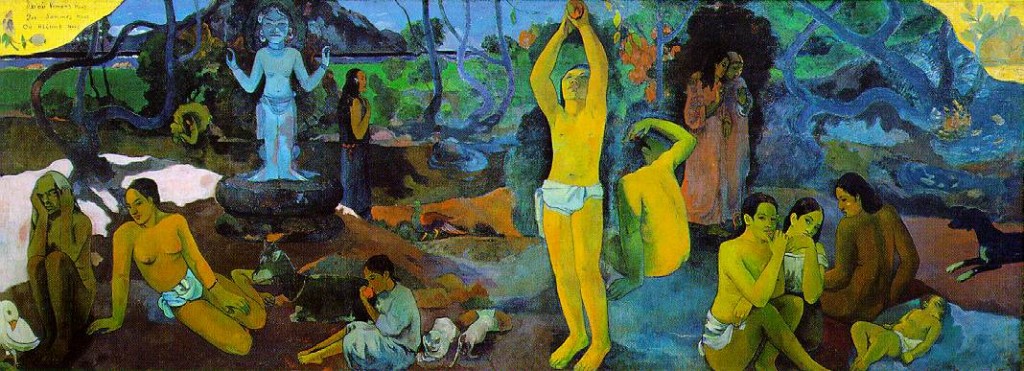About the project Basic Questions…
Author: Borut Savski
The project is a paraphrase of the title of the painting by Paul Gauguin (Where do we come from? What are we? Where are we going?, 1897/98), that (seemingly, at least to me) wanted to move the pivot of art from aesthetics to ethics. After more than a hundred years it looks like art has managed to get rid of the beautiful and is now dealing with questions of human existance.
Although it may seem that the technology of art has changed immensely from not so long ago (with today’s talk about the art of new media), it’s use is not in the least different. It is a simple (or less simple) prolongation of human body – with it’s mind and spirit (and the heart) – a prosthetics for an artist to present his/her thought/story. It is still about the sending of a message – in the form of an artistic artifact (or concept). If we presume that artists?s message is important enough for him to send it to public, it could be that it is important enough also for a fellow human.
In our case we approached the three questions, that we seem to have become accustomed with the thought that they will always remain without a definite answer – therefore useless, trivial…
But in the past the search for these answers was extensive. Almost up to this age the it was a quest of the various religious and mystical groups (the alchemists, the jewish kabbalists, the sholastics, philosophers). The search for basic questions has in the last two centuries moved to scientific research with it?s strong emphasis on experiment, so the more abstract spiritual approach (with various meditation and other cognitive techniques) has been put very much aside.
The answers so-far however have always been different (according to the cognition techniques, and the differing evaluation systems) – and among the different there is hardly any agreement. Our answers will be presented without much relation to standard dogms but also seriously – with the help of representations of life – with relatively simple dynamic – algoritmic kinetic (moving), (potential?), photo-dynamic (light, color) and dynamic sound structures/systems/creatures.
We will approach the human (and life) as a complete being. The question of life will be the most important. The definition so-far are not helpful. Is the Earth a living system (the Gaia theory)? If yes, is it therefore also a living creature? What is the difference between a creature and a system?
And on the self-defining human level: What is the result of the urge (wish) for survival and the lack of it? The meaning, the motivation = the inner motor, motivator. It is quite certain that without the meaning a human becomes a shell – a machine. And with only the urge a human is just an animal. Here I sense a lot of layers (and questions) of animal primary (lower) motivations (instincts,urges) and of the derivations (from lower to higher: sexual instinct becomes far more complex sexuality; love, but also responsability, and it could also be that it moves far away from seeking pleasure – becoming possesivity, hate). Or: the derivations of basic instinct of self-preservation – the fear – become highly regarded entities: heroism, (predanost,…), again responsability,…
It is also very interesting how the derivations of fear seem to have been established (in our societies) as more noble human (humaine) attributes than the derivations of a sexual instinct. But the derivations seem to be a combination of both of the basic instincts. Of course, it is quite clear that these derivations represent the roots of human civilization. And the two basic instincts probably represent the individual and the collective.
As the materialization of the project we will try to create some models of motivated entities (models of motivations?), that will have to recreate the self-reproduction (production of self?; self-creation, autopoesis) of the system/object. Here we will focus on creating an algoritm, that will produce an effect (an image; a representation) that will in some way reveal the attributes/parameters of the chosen motive/meaning.
The second question (Who are we?) also deals with self-cognition, self-identification. Since some of us are artists, we have to define what does that mean. What is art? This question is closely linked with Joseph Beuys (Was ist Kunst) and with the Slovene artistic group Irwin (Neue slowenische kunst; NSK). Beuys answers with an equation Kunst=Kapital (and introduces the social theory of Karl Marx), while Neue slowenische kunst answer it with Kunst=Politik.
In mathematics an equation is valuable, when it presents an answer to the unknown (in this case Art or Kunst). The presupposition is that we know what is Kapital and/or what is Politik. It then also tells us that Kapital=Politik. But if both sides of equation are unknowns, than we have to pose more questions (What is Politik?; What is Kapital?). However if we already know all the meanings then the equation becomes something that is in math called identity. This kind of result then has no value (2=3). It just tells us that we lost the variable (the unknown) somewhere. The answer to question is not possible. We made a mistake.
In humanistic sciences (especially in philosophy) the equation presents a paradox (in most extreme case we can even make an equation of two oppositions: all=nothing) and it is a rich source of new interpretations. In our case we (probably) don?t deal with two oppositions, but with comparison of tweo different (evaluation) systems/entities, therefore we really deal with re-evaluation (of one or the other). In the case of What is Art? we would like to find the answer in the form of Art=Ethics.
 my RSS
my RSS
